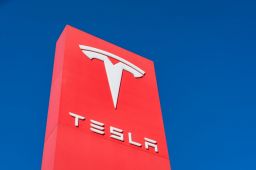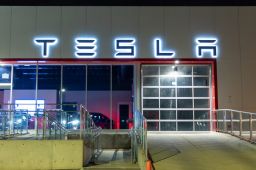Is Tesla finally ready to breakout?
Look at Tesla's stock price since 2010 and a clear pattern emerges. Since its IPO 15 years ago, Tesla's stock price has experienced three prolonged periods of stagnation and two major breakouts in between.Past performance isn’t a reliable indicator of future results.
- The first plateau was from 2010 to 2013. The first few years after its IPO. For these first few years, the stock went up by about 100%. Nothing to sneeze at, but modest compared to what came next.
- In 2013, the stock broke out and surged by nearly 600% in under a year. But then it settled down into a relatively flat 5-year stretch between 2014 and 2019. In that period, Tesla's stock remained volatile, but overall it didn't grow at all.
- Then came another huge breakout in 2020. Suddenly, Tesla's stock began to soar, rallying over 2,200% in under 2 years. But that rally lost steam in 2021, and Tesla's stock price settled into another long price plateau and its stock has been relatively flat ever since, trading in a narrow range as the company battles scandals and disappointing fundamentals, which we'll get into.
But some analysts seem to think that Tesla's luck is about to change. And a closer look at the stock over the past few weeks shows that investors might agree.
Since the beginning of September, Tesla's stock has rallied
And broken out above key resistance, although that rally has begun to sputter and lose some of its momentum. But still, this surge begs the question, is this the beginning of the next meltup in Tesla stock, or just a blip in a prolonged consolidation phase for Tesla, marred by internal strife and disappointing sales?
That's what we'll dig into in this video, and we'll start here with a chart showing Tesla's forward revenue going back to 2011.
Like most stocks, Tesla's price is driven by its ability to grow its revenue
The recent stagnation is directly tied to a slowdown in that growth story. For years, Tesla's revenue skyrocketed as it launched successful EV models and dominated the market.
However, since mid-2022, that explosive growth is stalled. A primary reason for this is simple challenges in growing vehicle sales.
Here we can see Tesla's car deliveries by year and quarter since 2017. After a period of rapid expansion from 2020 to 2023, Tesla's car sales have struggled to maintain that upward trajectory. They even slightly contracted in 2024 and that contraction has continued into Q3 2025.
During this same period, fierce competition has emerged, most notably from Chinese rival BYD. If we add BYD sales to this same chart, we can see that this Chinese EV maker has really come up from behind and in 2024 actually matched Tesla's car deliveries. It did this by offering vehicles at a significantly lower price point, often less than half the cost of Tesla's cheapest models.
Likely in response to this pressure, Tesla began aggressively cutting prices of their cars back in January 2023. While this made their cars more affordable, it came at a cost to their bottom line. Profitability.
Tesla's forward profit margin, which peaked above 16% in 2023, has since fallen dramatically to less than half that.
This compression of profit margins is a dynamic we saw during the 2014 to 2018 flat period for the stock.
When you have both stagnating sales and shrinking profit margins, the result is lower overall company profits or earnings.
Tesla's earnings per share have reflected this, falling from a peak of nearly $6 to around $2 today. In an era where most major tech companies are expanding their profits, Tesla is one of the few that has seen them contract, which is usually a red flag for Wall Street.
Speaking of red flags
Here's Tesla's forward price to earnings PE ratio, a measure of how much investors are willing to pay for each dollar of profit. It currently sits near 220. That's very high, especially for a company whose growth has stalled. It also indicates that a lot of the optimism on the stock might already be priced in.
The key to reigniting that excitement now rests on the successful launch of its next generation lower-cost vehicle. However, Tesla's been promising this for some time and is not yet delivered.
While long-term projects like the Optimus robot in a full-fledged robo taxi network are incredibly ambitious, they're unlikely to generate meaningful revenue in the short term.
Wall Street's focus is on the here and now, and the only thing that can truly move the needle is a catalyst for volume growth.
The new, more affordable model that's apparently in the pipeline is that catalyst, promising to open up a much larger segment of the market.
If there are further major delays with the new vehicle, or if it fails to drive the expected volume, investors could lose patience.
In that scenario, Tesla's valuation could deflate back towards levels more typical of a traditional automaker, which could mean a significant decline in the stock price.
This puts the stock in a precarious position with massive potential for both reward and risk.
At Capital.com, we'll keep you updated on the latest price movements of market leaders like Tesla. Explore more insights in our Educational Hub.

